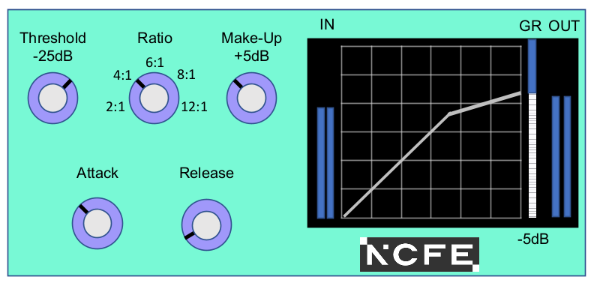Compression
1/9
Earn XP
Description and Tags
Music Tech || MT CA2 - The Digital Audio Workstation
Name | Mastery | Learn | Test | Matching | Spaced |
|---|
No study sessions yet.
10 Terms
What is dynamic processing?
Refers to any process that is affected by, and controls, the level of volume.
It’s essential when creating a balanced mix.
What is a balanced mix?
When every part can be heard throughout a mix at an appropriate level.
What is dynamic compression?
Reduces the volume (dB) of an audio signal.
This then means the signal has a more consistent dynamic range.
What is a dynamic range?
Difference in volume between the loudest and quietest part of an audio signal.

What are the five main controls in a compressor?
Threshold.
Ratio.
Attack.
Release.
Make-up Gain.
What is the threshold in compression?
The level (dB) at which the compressor will start to turn down the input signal.
Example: 0dB threshold would equal no compression, regardless of how loud the incoming signal is.
What is ratio in compression?
This is the ratio at which the compressor will turn down the incoming signal.
This is just a gain input to output ratio.
Example: 4:1 ratio.
For every 4dB of input level, 1dB will be output.
With an input signal of 12dB at a 4:1 ratio, 3dB would be output.
What is attack in compression?
This is the speed at which the compressor will start to turn down a signal once it has passed the set threshold.
Fast attack: the compressor will clamp down quickly on the incoming signal, leading to more aggressive sounding compression.
Slow attack: the compressor will take longer to respond to turning down the incoming signal, leading to smoother and more natural sounding compression.
What is release in compression?
This is the speed at which the compressor will start to let go of the incoming signal once it falls back below the threshold.
Fast release: the compressor will very quickly stop turning down the signal, only turning down the first part of the audio signal.
Slow release: the compressor will take longer to let go of an incoming signal, compressing it for longer and making the signal quieter overall.
What is make-up gain in compression?
Turns up the compressed signal.
This is important as compression will have made the overall signal quieter.
Sometimes compression is used to just turn down the louder parts and it is not necessary to use make-up gain.
Generally, you should only add the same amount of make-up gain that the compressor has turned down the signal.